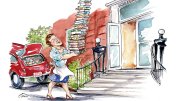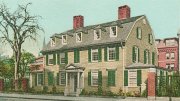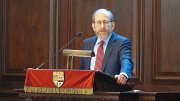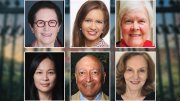1924
The statue of John Harvard is moved from the Delta, west of Memorial Hall, to today’s position at University Hall.
1939
Each undergraduate House has gradually acquired a nickname for its residents: “Gold Coasters” (Adams); “Pioneers” or “Funsters” (Dunster); “Elephants” (Eliot); “Deacons” (Kirkland); “Rabbits” (Leverett); “Bellboys” (Lowell); and “Puritans” (Winthrop).
The Harvard Crimson (reportedly sacrificing more than $2,000 in advertising) inaugurates “a campaign to eliminate [local] tutoring schools as an organized vice racket violating University rulings and ethics”; a front-page editorial denounces “intellectual brothels [where] cheating and illegitimate tutoring [are] elevated to…a large scale commercial enterprise,” thus enabling some undergraduates to pass courses without doing any work whatsoever, “making a mockery of a Harvard education, a lie of a Harvard diploma.”
1954
After 17 years of partial assistance, the Business School agrees to become a full partner in Radcliffe’s one-year Management Training Program, the “closest thing to a Harvard Business School education available for women.”
1974
Thanks to $180,000 from the National Endowment for the Humanities, the Faculty of Arts and Sciences has set up a major program of instruction in oral literature, including the study of folklore, natural magic, balladry, and mythology.
1984
Roger Brockett, McKay professor of applied mathematics, is assembling Harvard’s first robotics laboratory in an effort to improve ways to incorporate the humanlike capacities for vision, touch, and manipulation into a robot’s repertoire.
1989
Plans announced in January to assign one-sixth of the freshmen to the upperclass Houses randomly are retracted (at least for a year) by dean of the College L. Fred Jewett under pressure from irate first-years and worried House masters.
Olympians Lane MacDonald ’89 and Allen Bourbeau ’89 help lead the men’s hockey team to sudden-death overtime victory and the NCAA championship in St. Paul.








